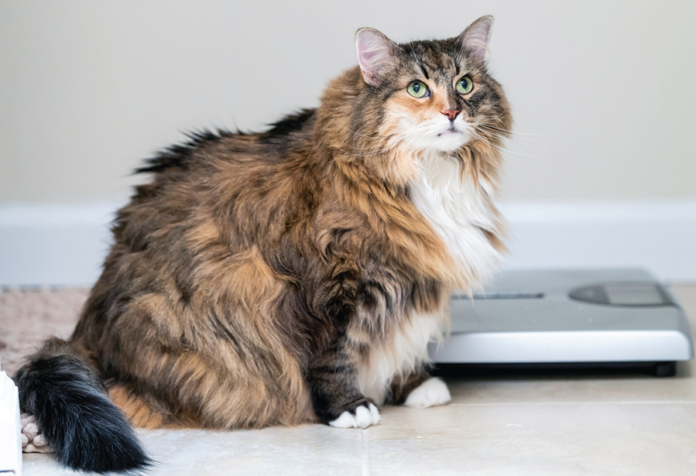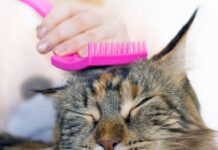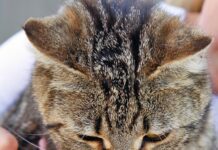
ablokhin | iStock photo
You’re petting your cat and you realize that her silky coat is not so silky anymore. Whether your attention has been grabbed by small knots, large deep-seated mats, or thick patches throughout the coat, your cat’s coat requires some human intervention to get it back up to snuff.
Mats and tangles are problematic for three reasons:
- They are painful when they tug on your cat’s skin.
- They trap moisture and bacteria next to the skin, providing the ideal environment for a skin infection to develop.
- Poor grooming habits can be a sign of a larger health problem.
Longhaired Cats
If your cat has a long, luxurious coat, check him at least once a week for developing knots. A brush or comb is often sufficient to brush out small knots and areas where the dead hair has clumped together, or you can very carefully trim knots with scissors (go slowly, as it’s easy to cut skin, too, especially if the mat is close to the skin). Catching knots early will prevent them from developing into full mats, which are more difficult to remove. Some cats may need to be inspected more often.
“A longhaired cat can get mats despite its best grooming efforts at any time, but especially around the yearly shed periods. Since the head and neck aren’t accessible to the tongue, this is where mats often are seen first,” says William Miller, VMD, DACVD, Professor Emeritus of Medicine, Section of Dermatology.
Shorthaired cats can get clumps and mats, too. If you notice a thick spot when petting your cat, make a note to monitor that area on a regular basis.
If your cat’s bad hair day seems to be a bit more than a mild grooming issue, consider other potential reasons. “Although people talk of the lazy groomer, those cats seem to be very uncommon, so one needs to look for the reason why the cat isn’t grooming as well or at all,” Dr. Miller says.
Topical Concerns
“Are any topicals (shampoos, flea and tick products, etc.) being applied?” asks Dr. Miller. “These items have a taste, and the cat may not like them.” You can give your cat a bath to help remove the bad taste (unless of course the shampoo was the problem) or brush your cat daily for a few days until he starts grooming himself again.
Check the Mouth
“Next, the mouth needs a good look. Any significant degree of gingivitis or glossitis (inflammation of the tongue) can make grooming uncomfortable,” says Dr. Miller. Red gums are a sure sign of dental health issues, along with calculus buildup and bad breath. Calicivirus is a feline respiratory disease known for causing ulcers on the tongue that you may be able to see when your cat opens his mouth. In addition to not wanting to groom, cats with oral discomfort may also eat less, chew abnormally, or drool when eating.
Internal Disease
Any systemic illness that causes your cat to feel ill can result in poor grooming habits. Think about when you are sick—do you go through your normal routine of brushing and styling your hair? Nope. Cats are the same way and don’t expend energy on grooming when they are feeling poorly.
If your cat has a persistently unkempt coat, it is time to visit the veterinarian. A wide range of conditions can cause your cat to have a poor coat or not feel well. Dr. Miller says, “The internal disease can be something simple like intestinal parasites or hairballs or something very serious like diabetes or cancer.”
Your veterinarian will start by doing a physical exam, checking the skin in the problematic areas for indications of parasites, and the mouth for signs of dental issues. Between the exam and the health and behavior history that you provide, your vet will narrow down possible causes. The next step might include bloodwork to check for metabolic abnormalities, a fecal exam to check for parasites, and/or radiographs (x-rays) to check for hairballs, an obstruction, or tumors.
Coat Management
Your cat’s veterinary team likely will get him cleaned up before you head home, but maintaining his coat until he is adequately grooming himself is up to you. Mats will be shaved as needed and smaller tangles combed out if your cat allows. For severe clumping and matting, a full-body shave (often called a “lion” shave) may be recommended to give your cat a clean slate.
Back at home, monitor your cat’s coat on a regular basis. When petting him, run your fingers through the hair behind his ears and on his belly and hind end, as these are common problem areas for mats and tangles to start. Brush him a little bit at least once a day until he is used to being brushed. Pay special attention to those problem areas to keep the hair smooth and untangled.
If your cat does not tolerate being brushed, a shave-down may be the best option. His hair will still be able to clump and mat when it grows back in, but he will have some quality time before the next shave.
If your cat does not tolerate being brushed, a shave-down may be the best option. His hair will still be able to clump and mat when it grows back in, but he will have some quality time before the next shave.



